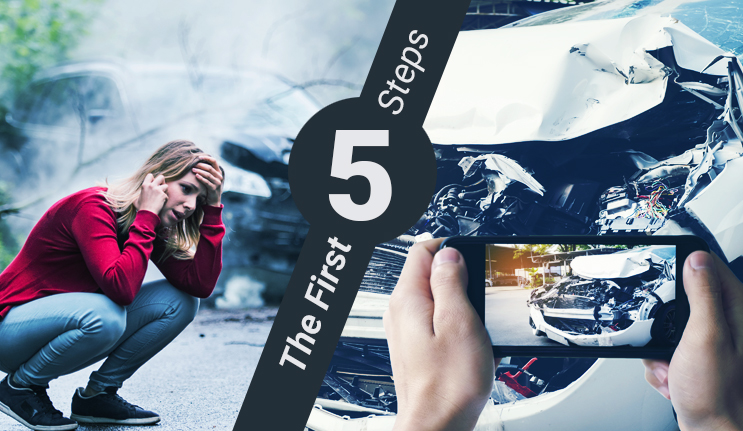There’s no real way to prepare for a motor vehicle accident. They occur in an instant and can have a huge impact on your life. You can, however, prepare a game plan in case you suffer an accident to protect both your physical and financial health. Below are the first five steps you should to take immediately following a vehicle accident.
Start with Your Own Safety
Personal safety must to be your primary concern after being involved in an accident because it’s going to impact the overall outcome of the incident. Do a quick check of yourself to see if you’re injured and, if so, how badly. Needless to say, seat belts save lives in vehicle crashes. Buckling up will greatly increase the odds you will be in good enough condition to make it through an ordeal like a motor vehicle accident.
If you’re not seriously injured, it’s time to check on anyone else who is in your vehicle to see if they can move on their own or if it is safe to move them. Take note of their specific injuries and record them if possible.
Your next goal is to protect everyone else on the road. If possible, move your vehicle to a safe place out of moving traffic and make sure that it’s as visible as possible. Turn on your lights and your hazards, if they still work, and deploy any additional road safety equipment (e.g., signs, flares, etc.) you might have in your vehicle. Once these tasks are accomplished, if other vehicles are involved, check on their occupants to determine if assistance is required.
Get Help
Your next step is assessing what type of emergency help you need. If anyone involved in the accident appears to be injured, call 911 immediately. If you’re not sure whether someone is injured, it’s better to be safe than sorry. Summon help from first responders promptly.
Once you’ve taken care of yours and everyone else’s safety, you should seek assistance in documenting the scene of the accident. Call the local police, even if another party requests to keep law enforcement out of the matter or to handle the problem without insurance. Creating an accident report will be incredibly helpful as you move forward, especially in the event someone gets their insurance company involved later or if the case morphs into litigation.
Collect the Necessary Information
It’s a good idea to start gathering more information as you wait for the police. At a very basic level, this means exchanging information with the other driver. You need their insurance information, license plate info, name, physical address and primary phone number. The more identifying information you can get, the better.
It’s also wise to act as if you are already gathering evidence for a legal case. That means writing down all the pertinent info you can access—the name of every passenger involved in the accident, the make and model of all vehicles, the location of the accident, and even the date and time. You should also make sure to get the badge number of the responding officers and try your best to document the contact information for any eyewitnesses to the collision.
Take Pictures
A good picture is worth a thousand words (or even more!), so make sure to document the accident with your phone’s camera. Of course, don’t do this in a way that interferes with the police investigation. But do make sure that you gather the information quickly—even if that means waiting until the police leave to take your pictures.
Your documentation should also include any damage done to your vehicle, other vehicles and even to your own body. Given that this information can and will change as time passes, creating an immediate record can help you out immensely in the future.
Fix Your Car and File a Claim
Finally, call your insurance company. There should be a contact number on your insurance card, and if you can’t find it you can check on the carrier’s website. When properly filed, your insurance company will help you through the claims process, including working with the other driver’s insurance company.
From here, you’ll need to get your car repaired. Talk to your insurance company about approved repair facilities and then make a call to receive an estimate. You’ll want to keep the price of your repairs down as much as possible, so it’s often a good idea to call around to find an approved shop that will give you a fair price.
About the Author

Samantha Tung is a contributing writer and media specialist for Caliber Collision. She often contributes content for a variety of car safety blogs.
Stay safe on the road with these online training courses:
Smartphones and Smarter Driving (Micro Course)



